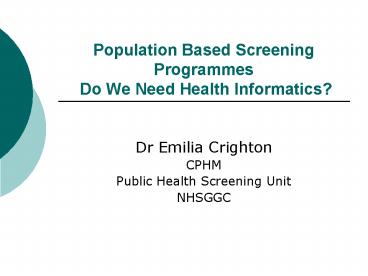Population Based Screening Programmes Do We Need Health Informatics - PowerPoint PPT Presentation
1 / 30
Title:
Population Based Screening Programmes Do We Need Health Informatics
Description:
Pregnancy and newborn screening programmes: communicable diseases; Down's ... Abdominal Aortic Aneurysm. NHSGGC Public Health Screening Unit. Challenges: Governance ... – PowerPoint PPT presentation
Number of Views:38
Avg rating:3.0/5.0
Title: Population Based Screening Programmes Do We Need Health Informatics
1
Population Based Screening Programmes Do We Need
Health Informatics?
- Dr Emilia Crighton
- CPHM
- Public Health Screening Unit
- NHSGGC
2
NHSGGC Public Health Screening Unit
- 1.2 mil population
- 237,000 eligible p.a.
- Cancer screening programmes cervical breast
bowel - Pregnancy and newborn screening programmes
communicable diseases Downs syndrome and other
foetal anomalies newborn bloodspot (PKU
hypothyroidism CF) - Newborn Hearing Screening
- Diabetic Retinopathy
- Pre School Vision Screening
- Abdominal Aortic Aneurysm
3
NHSGGC Public Health Screening Unit
- Challenges
- Governance
- Failsafe
- Annual reports
4
Project Scope
- Project Scope - To develop an integrated IT
System to support the pregnancy and newborn
bloodspot screening programme being rolled out
across Greater Glasgow Clyde- - Pregnancy Newborn Screening Programme
- Downs Syndrome and Neural Tube Defects (1st
Trimester CUBS, 2nd Trimester serum, Fetal
Anomaly Scan) - Communicable Diseases in Pregnancy (HIV,
Syphilis, Hepatitis B, Rubella) - Haemoglobinopathy (Sickle cell disorders,
Thalassaemia) - Newborn Bloodspot (PKU, CHT, CF, MCADD, Sickle
Cell)
5
Project Challenges
- Project Challenges
- Minimise the need for manual data entry and
duplication of information by extracting data
from existing systems and loading into the
screening system automatically via electronic
interfaces. - Proliferation of existing IT systems and business
processes across GGC maternity services. Each
Maternity Unit using different IT systems and
processes. - Maternity services are currently undergoing a
redesign to a hub and spoke structure which is
not yet finalised. - Planned move of QMH maternity services from
Yorkhill.
6
Application Users
- Key Application Users
- Midwives
- Community Midwives
- Ultrasonographers
- Doctors
- Health Records
- Public Health Screening Unit
- Public Health Protection Unit
- Child Health
- Laboratories
7
The Application
- The application -
- is Web based (Microsoft .NET).
- developed in-house by GGC HIT
- can be accessed via the Clinical Portal
application. - uses role based security to ensure that users
only see the information they need to do their
job. - provides a number of Data Entry screens to
support manual data entry when required. - has interfaces to SCI store to retrieve
electronic referrals and screening test results. - has an electronic interface to Scottish Birth
Record (SBR) to retrieve details of GGC births. - provides Public Health Screening Unit with KPI
reports . - provides clinical staff with control and planning
reports. - provides a facility to batch print screening test
results letters. - provides a clinical alert mechanism to highlight
process issues e.g. overdue test results.
8
Key System Interfaces
9
Screening Episode
10
Referral
11
Screening Registration
12
Booking Visit
13
Routine Bloods
14
Dating Scan
15
Communicable Disease Screening
16
Fetal Anomaly Scan
17
Fetal Anomaly Scan
18
Outcomes
19
Patient Contacts
20
Registration Management
21
Patient Management
22
Alert Management
23
KPI Reports
- KPI reports have been developed to monitor the
success of the screening programme in NHS GGC.
Reports include- - Total number of women offered screening.
- Total number of women accepting screening.
- Total number of women receiving high
risk/abnormal/positive screening test. - Total Number of women accepting further
diagnostic testing. - Total Number of women with low risk/normal/negativ
e screening test who went on to have baby with
Downs syndrome or a fetal anomaly. False
Negative. - Total Number of women with high
risk/abnormal/positive screening test who went on
to have baby without Downs syndrome or a fetal
anomaly. False positive - Total Number of women receiving results of
screening tests out with the Clinical Standards.
24
Control Reports
- Control reports have been developed to highlight
issues with the screening programme. Reports
include- - Patient screening summary report.
- Screening programme summary report.
- Positive/abnormal test results summary report.
- Overdue results summary report.
- Unrecorded outcomes.
- Alert summary report.
- Booking visit DNA report.
- Screening test summary report
25
Project Milestones
- Key Project milestones-
- Aug/Sep 2009 System Testing
- Oct/Nov User training for Clyde based staff
- Nov/Dec Go live in Clyde (IRH, RAH, VOL)
- Jan/Feb 2010- User training for Glasgow based
staff - Jan/Feb 2010 Go live in Glasgow (SGH, PRMH)
26
NHSGGC Bowel Screening
- Main features
- Integrated to SCI-Gateway
- Imports Positive Referrals
- Generates letters to the patient, the GP and to
SBoSC - Records Pre-Assessment Administration data
- Imports Patient History
- Records Pre-Assessment Data
- Records Colonoscopy Data
- Tracks Patient Progress through the Process
- KPI Reports
27
Teaser Letters
28
(No Transcript)
29
(No Transcript)
30
Health Informatics?
- Information science
- Computer science
- Health care
- Medical knowledge
- Project management
- Change management
- Courage
- Leadership































